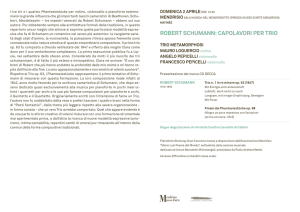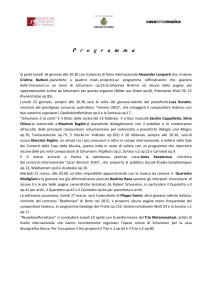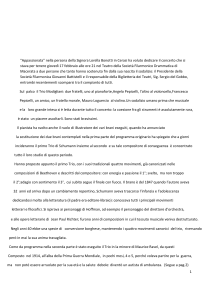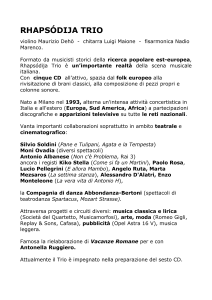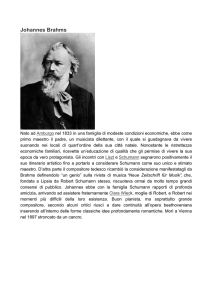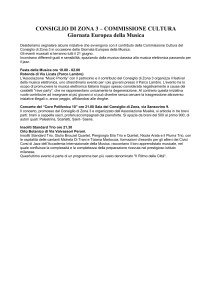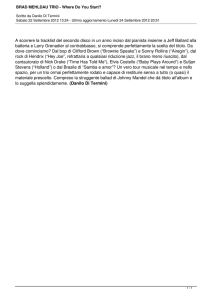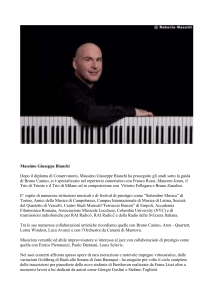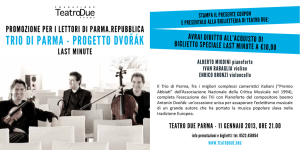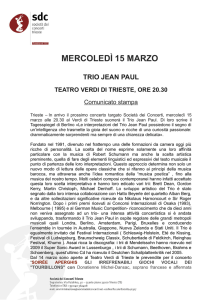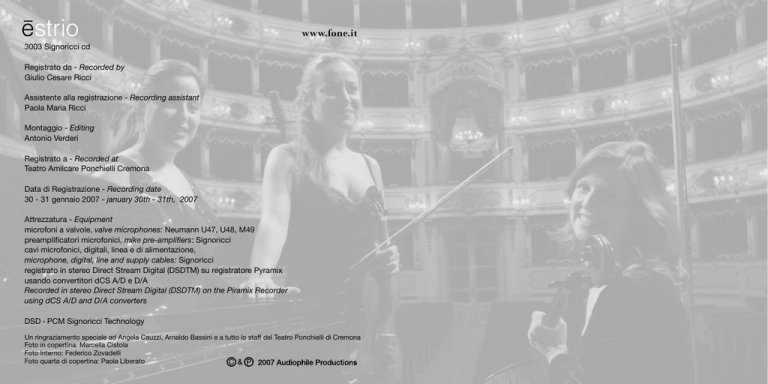
www.fone.it
3003 Signoricci cd
Registrato da - Recorded by
Giulio Cesare Ricci
Assistente alla registrazione - Recording assistant
Paola Maria Ricci
Montaggio - Editing
Antonio Verderi
Registrato a - Recorded at
Teatro Amilcare Ponchielli Cremona
Data di Registrazione - Recording date
30 - 31 gennaio 2007 - january 30th - 31th, 2007
Attrezzatura - Equipment
microfoni a valvole, valve microphones: Neumann U47, U48, M49
preamplificatori microfonici, mike pre-amplifiers: Signoricci
cavi microfonici, digitali, linea e di alimentazione,
microphone, digital, line and supply cables: Signoricci
registrato in stereo Direct Stream Digital (DSDTM) su registratore Pyramix
usando convertitori dCS A/D e D/A
Recorded in stereo Direct Stream Digital (DSDTM) on the Piramix Recorder
using dCS A/D and D/A converters
DSD › PCM Signoricci Technology
Un ringraziamento speciale ad Angela Cauzzi, Arnaldo Bassini e a tutto lo staff del Teatro Ponchielli di Cremona
Foto in copertina: Marcella Cistola
Foto Interno: Federico Zovadelli
Foto quarta di copertina: Paola Liberato
Often we should stay quiet...
But a zither set every hour to music
And maybe pleases transcendental beings getting closer.
Hand it to me so it will almost be appeased
The pain that came between the joy.
These pains often, willing or not, in the souls
a bard has to take, but others not.
Dmitrij Sostakovic was born in 1906 and his history makes him one the most outstanding
and controversial artists of the Sovietic Union. He died in 1975.
Most of Dmitrij Sostakovic’s chamber operas were dedicated to Quartets for strings, a corpus
of 15 operas, which equal the number of the Symphonies to which the Russian composer
dedicated himself starting from 1938, accentuating his work in this field in elderly age.
In addition to the Quartet compositions, Sostakovic’s chamber production, far from being
abundant, is concentrated in the two Suites for jazz orchestra, in the three Sonate for
string instrument (cello, violin and viola), in the Piano Quintet op. 57 and the Trio op. 67.
If the Quintet can be considered an amiable opera, the Trio for violin, cello and piano op.67
is mournful, with strong dramatic tones and macabre passages: the struggling elegiac
modulation is often spaced with a grotesque dance. The general mood of the opera reflects the
circumstances in which it was composed: the Trio, was composed at the beginnings of 1944,
during the war, and dedicated to the memory of Ivan Sollertinskij, who died prematurely in
February, that same year (“the death of Sollertinskij is a serious loss in the music panorama.
There are no men who had loved music with the passion and warmth of Sollertinskij”).
The opening Andante, with its contrapuntal writing, is characterized by the high
harmonious sounds of the cello and by an oriental melodic scheme, that will be renewed in the
future moves. Then follows Allegro non troppo, of extraordinary vitality, which calms down in the
Largo, a passacaglia bass, so slow as to appear immovable, consigned to the keyboard of the
piano, which together with the string instruments draws refined harmonies. The final Allegretto
has the typical vitality of the Balkan music, which ends only after having recalled the harmonies
of the introduction and the theme of the passacaglia.
Arnaldo Bassini
English Traslation: Daniele Battaglia
Dmitrij Šostakovic
Trio n. 2 in mi minore op. 67 (1944)
per violino, violoncello e pianoforte
1) Andante › 8.11
2) Allegro non troppo › 8.41
3) Largo › 4.46
4) Allegretto › 5.42
Robert Schumann
Trio in fa maggiore n. 2 op. 80 (1847)
per violino, violoncello e pianoforte
5) Sehr lebhaft (Molto allegro) › 6.58
6) Mit innigem Ausdruck (Con intima espressione) › 3.02
7) In mässiger Bewegung (In moto moderato) › 4.44
8) Nicht zu rasch (Non troppo presto) › 9.55
L’aspirazione infantile di Robert Schumann (1810-1856) era quella di divenire poeta.
E anche se a 12 anni aveva dato vita con i suoi compagni ad una piccola orchestra, aveva già
composto un salmo e leggeva Mozart, Haydn e Weber; era la letteratura a suggestionare la sua
mente. Le sue letture spaziavano da Bayron, che lo esaltava, a Goethe, da Schiller a Richter.
E dopo aver dato vita ad una società letteraria, pretendeva di dissertare con i suoi coetanei
sui classici e sui romantici. In seguito, a 15 anni, il lacerante dilemma della duplice vocazione
e l’angosciata confessione: “Nella gioventù ci sono momenti in cui il cuore non riesce a trovare
quello che vorrebbe, perché, oscurato da una nostalgia inesprimibile, dalle lacrime, non sa
quello che cerca”. E ancora: “... Chi sono realmente, non lo so nemmeno io...
Se sono un poeta – poiché nessuno lo può diventare – sarà il destino a deciderlo, un giorno”
(Diari, 1827). Di fatto però la musica, dopo la parentesi degli anni dedicati allo studio della
“fredda giurisprudenza”, diverrà non solo l’occupazione esclusiva, ma una vera ossessione.
Allievo di pianoforte di Friedrich Wieck dal 1830, due anni dopo doveva rinunciare definitivamente alla carriera di virtuoso, essendosi rovinato un dito nel corso di assurdi esperimenti
fatti nel tentativo di migliorare la sua tecnica. Sarà dunque la composizione ad assorbire le
sue energie, e nei primi anni, in particolare, quella pianistica. Ma non solo: con il suo entourage
di musicisti e appassionati, la “Lega di David”, fondò, nel 1834, la Neue Zeitschrift für Musik,
rivista che si faceva interprete dello slancio verso il rinnovamento della musica. Anche questa
nuova avventura lo assorbì in misura esagerata: per anni fu il redattore unico della rivista,
scrivendo un gran numero di articoli e sostenendo altrettante polemiche.
Al peso del lavoro – le sue composizioni faticavano ad entrare nel gusto del pubblico, perché
considerate troppo complesse – si aggiunsero le pene private: il vecchio Wieck gli negò per
anni la mano della figlia Clara, raffinata musicista e pianista, perché, pur riconoscendo il talento
di Robert, ne temeva lo scarso equilibrio psicologico. Il matrimonio si poté celebrare solo nel
1840, alla maggiore età di Clara, e furono anni felici e fecondi. Schumann allargò la sfera dei
suoi interessi musicali: alla produzione per pianoforte affiancò quella liederistica, sinfonica e
da camera.
But Schumann found even in these circumstances the strength to compose and, just while
he was conceiving the idea of the marvellous Album für die Jugend op. 82, he returned to
chamber music with two Piano Trios, in which he freed his tormented imagination
(he will compose a third one, the op. 110 in 1851).
Such operas stand with an innovation apparently formal, but mean a lot more. Robert is
the first to substitute the traditional Italian terminology of moves with indications in German,
capable of reflecting the expressive contents, so becoming proper interpretative suggestions.
In Trio in F major n.2 op. 80, we cannot find the fire of Trio in D minor n. 12 op. 63, but the
expressive tone is lyric and the discourse based on the rigour of the contrapuntal composing
(this piece sounds like a homage to Johann Sebastian Bach) proceeds with the peacefulness
of nostalgia, giving moments of authentic poetry.
The softness of this piece soon captured Clara, who often included it in her concert
programmes; Schumann himself, in spite of the taste of the audience who preferred the
former, confessed to one of his students that Trio in F major “exercises a more immediate and
charming seduction”. The beginning, Molto animato, occurs with the exuberant performance
of the two themes different one from the other: the first colourful and lively, the second, as
in the tradition, sweet and cantabile, but soon after a melody of descendant modulation
completely different from this thematic sound arises: it is a struggling love song.
A song which with variations becomes the first theme of the second movement, Con
espressione to which follows a new scenario: keyboard and cello play a tough basso on
which the violin plays its variations. A new rhythmical section leads to the epilogue in which
all instruments play a series of cadenza. The Scherzo is substituted with a short bipartite
movement, In moto moderato, where the themes are characterized by deep changes in the
melodies of the arches. A thematic return to the first movement ends the Trio: Non troppo
presto is a statement of optimism that has as protagonist the piano taking the strings and the
keyboard to a fast dialogue at the same time contrapuntal and harmonizing. It is surely arbitrary
to associate the biographical happenings of an artist to his operas, but it is also true that in the
case of Schumann, as in many other romanticist musicians, poets and painters, the boundaries
between the two spheres are almost inexistent.
The contrasting love with Clara emerges in all of his operas, so do his professional delusions
and the harsh artistic critics. Schumann can be seen as a romantic poet lively described in an
elegy by Hölderlin, who analogously and even before Schumann, was exhausted by madness:
Robert Schumann’s (1810 – 1856) juvenile aspiration was to become a poet. Even though at
the age of 12 together with some of his friends he founded an orchestra, composed a psalm
and read Mozart, Haydn and Weber literature was going to influence his mind. His readings
went from Byron, who exalted him, to Goethe; from Schiller to Richter. He founded a literary
club and pretended to argue together with his friends about the classics and the romantics.
Later, at the age of 15, the tearing dilemma of the double vocation and the anguishing
confession: “In youth age there are moments in which the heart is unable to find what it really
wants, because overshadowed by a secret nostalgia and by tears it does not know what it is
looking for”. And yet: “...I am not aware of who I really am ... If I’ll be a poet one day – because
nobody can become one – destiny will decide it” (Diaries, 1827). Music, after the short period
of time he dedicated to the studying of the “cold jurisprudence”, will become not only his
exclusive occupation, but a true obsession for him. He was Friedrich Wieck’s piano student
since 1830, two years later he had to give up the career of virtuoso because he hurt his finger
during absurd experiments in order to improve his technique. Composition will then absorb
all of his energies, and in the first years he will work for the piano. But not only that.
With his entourage of musicians and acclaimers “The David League”, in 1843 he founded
the Neue Zeitschrift für Musik, a review with the purpose of giving a new freshness to music.
This new adventure absorbed all of his strengths. For years he was the head editor of the
magazine, writing several articles and bearing several critics. In those years work increased
– his compositions had difficulties in finding the please of the audience because considered
too complex – and private troubles followed: Mr Wiek for years denied him the hand of her
daughter Clara, a fine musician and piano player, because even though he was aware of
Robert’s talent, he feared for his psychological equilibrium.
The wedding was celebrated only in 1840, at the full age of Clara; and those were years of
happiness and fruitfulness. Schumann extended the sphere of his musical interests, to the
piano production he included lieder, symphonic and chamber productions. As a consequence
of the equilibrium he found living with Clara, the great chamber operas dated 1842 come to
life: the three Strings Quartets op. 41, the Quintet op. 44 and the Quartet op.47, for piano and
strings; both in E flat major. This is the exploration of a new sound world, in particular for the
formal aspects, conducted with a extraordinary creative energy.
The following years record an alternation of happy moments and nervous breakdowns, physical
and mental infirmity, due to inconsolable mourning as the death of his friend Mendelssohn in
November 1847, an event which provoked in him obsessions and frights.
Frutto del ritrovato equilibrio al fianco di Clara Wieck sono le grandi opere cameristiche del
1842: i tre Quartetti per archi op. 41, il Quintetto op. 44 e il Quartetto op. 47, per pianoforte
e archi, entrambi nella tonalità di mi bemolle maggiore. Si tratta dell’esplorazione di un mondo
sonoro nuovo, soprattutto per gli aspetti formali, condotta con una straordinaria energia
creativa. Gli anni successivi dovevano registrare un altalenare continuo di momenti sereni,
di disturbi nervosi, di crisi depressive, di cedimenti fisici, aggravati anche da inconsolabili lutti.
Come quello che lo colpì nel novembre del 1847: la morte dell’amico Mendelssohn, un evento
che risvegliò in lui ossessioni e terrori.
Ma Schumann trovò anche in questa circostanza la forza per comporre,: e proprio mentre
concepiva l’idea del meraviglioso Album für die Jugend op. 82, tornava alla musica da
camera con due Trii con pianoforte in cui dava libero sfogo alla sua tormentata immaginazione
(ne comporrà un terzo, l’op. 110, nel 1851). Queste opere si presentano con una novità
apparentemente solo formale, in realtà dai significati profondi: Robert per primo sostituisce
la tradizionale terminologia italiana dei movimenti con indicazioni in tedesco che ne riflettano
i contenuti espressivi, diventando così dei veri e propri suggerimenti interpretativi.
Non c’è, nel Trio in fa maggiore n. 2 op. 80, il fuoco del Trio in re minore n.1 2 op. 63 :
qui, se mai, la cifra espressiva è lirica, e il discorso, che si avvale del rigore della scrittura
contrappuntistica (quest’opera suona come un omaggio a Johann Sebastian Bach), procede
con la pacatezza della nostalgia, regalando momenti di poesia autentica.
La delicatezza di quest’opera conquistò subito Clara, che spesso la inserì nei suoi programmi
concertistici; lo stesso autore, a dispetto dei gusti del pubblico che prediligeva il primo,
confessò ad un allievo che il Trio in fa maggiore “esercita una seduzione più immediata e
fascinosa”. L’esordio, Molto animato, avviene con l’esuberante esposizione di due temi assai
diversi tra loro: il primo movimentato e saltellante, il secondo, come vuole tradizione, dolce
e cantabile; ma subito dopo affiora una melodia ad andamento discendente del tutto avulsa
da questo materiale tematico, uno struggente canto d’amore. Un canto che, variato, diventa
il primo tema del secondo movimento, Con espressione, alla cui esposizione fa seguito uno
scenario inedito: tastiera e violoncello realizzano un basso ostinato su cui il violino ricama le sue
variazioni. Una nuova sezione ritmica porta all’epilogo, in cui gli strumenti si producono in una
serie di cadenze. Lo Scherzo è sostituito da un breve movimento bipartito, In moto moderato,
i cui temi sono caratterizzati dai salti vertiginosi delle melodie degli archi.
Estrio is the result of a quest for the ideal balance between the creation of a seamless musical
experience and the unveiling of the personality of each individual artist.
Estrio is where the paths of three young Italian musicians cross. Violinist Laura Gorna, cellist
Cecila Radic and pianist Laura Manzini are regarded as being among the best performers of the
new generation. Their musical vision stems from a shared background, their education having
taken place under the aegis of the great Italian school of the likes of Salvatore Accardo, Rocco
Filippini and Bruno Canino, with whom they have been performing for years in a variety of
occasions and chamber ensembles.
Through the years, Laura Gorna, Cecilia Radic e Laura Manzini have played with performers
such as Bruno Giuranna, David Finckel, Rainer Kussmaul, Toby and Gary Hoffmann, Franco
Petracchi.
They have performed for the most prominent Italian festivals, societies and venues, such as
Teatro alla Scala, Serate Musicali di Milano, Unione Musicale di Torino; Amici della Musica di
Firenze, Vicenza, Palermo, Mestre e Padova; Teatro San Carlo e Associazione Scarlatti di
Napoli; Auditorium Parco della Musica, Filarmonica Romana; Società dei Concerti di Milano;
the Ravello, Camerino, and Sorrento festivals.
Their international experience has stretched far beyond European borders, from Japan to the
US, to South America and the Middle East.
The breadth of Estrio’s artistic interests has led them to collaborations with performers
belonging to fields as diverse as jazz, theatre, choreography, ultimately resulting in projects
such as Lieber Schumann - an introspective musical-theatrical exploration of the great
composer’s chamber music performed at Unione Musicale in Turin, Serate Musicali in Milan
and in 2008 in Bologna for Musica Insieme- and Intorno a Mozart, for which Estrio has
commissioned pieces to a variety of emerging composers.
Estrio nasce dalla ricerca di un equilibrio ideale, volto a creare un’esperienza musicale unitaria,
facendo nel contempo emergere il carisma individuale delle interpreti.
Estrio è frutto dell’incontro di tre giovani musiciste italiane. Laura Gorna (violino), Cecilia Radic
(violoncello) e Laura Manzini (pianoforte) sono considerate fra le migliori interpreti della nuova
generazione. Ad accomunarle, peraltro, la loro formazione musicale, alla grande scuola italiana
di Salvatore Accardo, Rocco Filippini e Bruno Canino, con i quali si ritrovano ormai da anni in
diverse formazioni cameristiche.
Laura Gorna, Cecilia Radic e Laura Manzini hanno arricchito la propria esperienza al fianco
di strumentisti quali Bruno Giuranna, David Finckel, Rainer Kussmaul, Toby e Gary Hoffmann,
Franco Petracchi.
Hanno all’attivo numerosi concerti per le maggiori stagioni concertistiche italiane, tra cui Serate
Musicali, Teatro alla Scala di Milano, Unione Musicale di Torino; Amici della Musica di Firenze,
Vicenza, Palermo, Mestre e Padova; Teatro San Carlo e Associazione Scarlatti di Napoli;
Auditorium Parco della Musica, Filarmonica Romana; Società dei Concerti di Milano; Festival
di Ravello, Camerino, e Sorrento. La loro esperienza internazionale si estende ben oltre i confini
europei: dal Giappone agli Stati Uniti, dal Sud America al Medio Oriente.
L’eclettismo e il desiderio di sperimentazione spingono Estrio a collaborare con artisti
provenienti da esperienze espressive eterogenee, quali il jazz, il teatro, la coreografia.
Da questo spirito di ricerca nascono progetti quali Lieber Schumann, viaggio introspettivo
intorno alla musica da camera del grande compositore (in collaborazione con Maddalena
Crippa) realizzato fra gli altri per l’Unione Musicale di Torino, Serate Musicali di Milano e nel
2008 per Musica Insieme Bologna e Intorno a Mozart, per il quale Estrio ha peraltro
appositamente commissionato brani a diversi compositori emergenti.
Il nome Estrio nasce dalla fusione tra il richiamo alla nota es (notazione tedesca) e la consonanza con il concetto di estro: l’ardore della fantasia e dell’immaginazione, o – secondo gli antichi
Greci – l’azione del nume, ricca di magica esaltazione, che stimolava il mortale nell’entusiasmo
profetico o poetico.
Un ritorno tematico al primo movimento chiude il Trio: il Non troppo presto è una affermazione
di ottimismo che vede protagonista il pianoforte e che chiama archi e tastiera ad un serrato
dialogo nello stesso tempo contrappuntistico e concertante.
E’ certamente arbitrario legare agli avvenimenti biografici di un artista la sua opera; è però vero
che nel caso di Schumann, come di tanti altri musicisti e poeti e pittori romantici, i confini tra le
due sfere sono quasi inesistenti: il contrastato amore con Clara affiora da ogni sua opera, così
come le delusioni professionali e le aspre polemiche artistiche. E allora a Schumann potremmo
attribuire il ritratto del poeta romantico vividamente descritto in una elegia da Hölderlin, che
analogamente e ancor prima di lui era stato reso incosciente di sé dalla follia:
Spesso dobbiamo tacere...
Ma una cetra presta i suoni ad ogni ora
E forse allieta celesti esseri che si avvicinano.
Porgetemela: e in tal modo, sarà quasi placata
Anche la pena che venne in mezzo alla gioia.
Di queste pene, voglia o non voglia, nell’anima
Deve un cantore portarne, e spesso, ma le altre no.
Dmitrij Šostakovic , morto nel 1975, era nato nel 1906: la sua storia ne fa la personalità d’artista
più emblematica e controversa della breve storia dell’Unione Sovietica.
Gran parte delle fatiche cameristiche di Dmitrij Šostakovic� sono state dedicate ai Quartetti per
archi, un corpus di quindici opere, tante quante le Sinfonie, cui il compositore russo si dedicò
a far tempo dal 1938, accentuando il suo impegno in questo campo nell’età più matura.
Al di fuori di quella quartettistica, la produzione da camera di Šostakovic, tutt’altro che copiosa,
si concentra essenzialmente nelle due Suite per orchestra jazz, nelle tre Sonate per strumento
ad arco (violoncello, violino e viola), nel Quintetto con pianoforte op. 57 e nel Trio op. 67.
E così come il Quintetto è un’opera di grande amabilità, il Trio per violino, violoncello e
pianoforte op. 67 è funereo, con forti colorazioni drammatiche e con cedimenti al macabro:
lo struggente andamento elegiaco è spesso attraversato da sezioni di danza grottesca.
Al clima generale dell’opera forse non sono estranee le circostanze in cui è stata composta:
il Trio, infatti, ha visto la luce nei primi mesi del 1944, in pieno periodo bellico, ed è dedicato
alla memoria di Ivan Sollertinskij, morto prematuramente nel febbraio di quell’anno (“La morte
di Sollertinskij è una grave perdita per la vita musicale. Non ci sono molti uomini che abbiano
amato la musica con la passione e il calore di Sollertinskij”).
L’Andante introduttivo, dalla scrittura contrappuntistica, è caratterizzato dai suoni armonici
molto acuti intonati dal violoncello e da un disegno melodico d’impronta orientale, che si
rinnoverà anche nei movimenti asuccessivi. In seconda posizione trova posto un Allegro non
troppo di straordinaria vitalità, che si placa nel Largo, un basso di passacaglia, tanto lento da
sembrare immobile, affidato alla tastiera del pianoforte, che con il concorso degli strumenti
ad arco disegna raffinatissime armonie. Ha la vitalità ritmica tipica della musica balcanica
l’Allegretto finale, che non chiude prima di aver rammentato gli armonici dell’introduzione e
il tema della passacaglia.
Arnaldo Bassini

